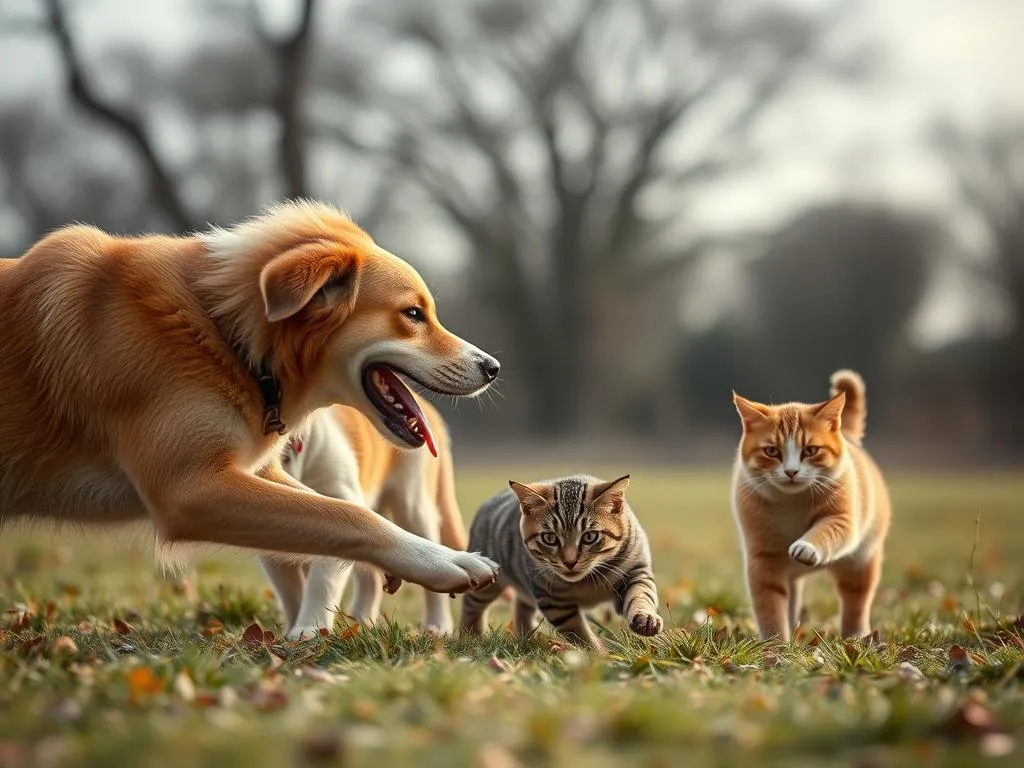
Understanding dog behavior is essential for every pet owner, especially when it comes to the often-controversial relationship between dogs and cats. Many dog owners have experienced the scenario: a dog spots a cat and takes off in a chase, leaving both pets bewildered and stressed. This article delves into the reasons behind this behavior, exploring the underlying instincts and offering insights into how to manage and mitigate chasing incidents.
Understanding Dog Behavior
Basics of Canine Behavior
Dogs are social creatures that communicate through body language, vocalizations, and even scents. Their behavior is influenced by a combination of instinct, training, and socialization. For example, a well-socialized dog is more likely to interact positively with other animals and humans. On the other hand, a lack of early socialization can lead to fearful or aggressive behaviors, including chasing.
Instinctual Behaviors
Among the various instinctual behaviors, one of the most prominent is the prey drive. This is the innate instinct to chase and capture prey, which can be traced back to their ancestors. Different breeds exhibit varying levels of prey drive; for instance, herding breeds like Border Collies may chase cats as part of their instinct to herd, while terriers, bred for hunting, may chase smaller animals due to their strong prey instincts.
Reasons Why Dogs Chase Cats
Prey Drive
Prey drive is a fundamental reason why dogs chase cats. This instinct has evolutionary significance, as it stems from a dog’s need to hunt for food in the wild. Breeds such as Greyhounds, Whippets, and Jack Russell Terriers are known for their high prey drive, making them more likely to engage in chasing behavior. Understanding this instinct is crucial for pet owners, as it helps explain why their dogs may react strongly when encountering a cat.
Territorial Instincts
Dogs are naturally territorial animals. When a dog sees a cat in its space, it may perceive the feline as an intruder. This territorial behavior can trigger a chase response, as the dog attempts to assert dominance over its area. Dogs use scent and markings to establish territory, and a cat wandering into this space can prompt a defensive reaction.
Playfulness
Not all chasing behavior is aggressive. Sometimes, dogs chase cats out of sheer playfulness. A dog may see a cat running and engage in a chase purely for fun. To differentiate between playful and aggressive chasing, pet owners should look for specific signs. Playful chasing usually involves a relaxed body posture, wagging tails, and playful barks, while aggressive behavior may display stiff body language, growls, or bared teeth.
Fear and Anxiety
Chasing can also be driven by fear. If a dog has had negative experiences with cats in the past, it may chase them out of anxiety or an instinctual flight response. This is often seen in rescue dogs or those with a traumatic background. Understanding the relationship between a dog’s experiences and its reaction to cats is essential for managing this behavior effectively.
The Impact of Dog-Cat Chasing
Stress on Cats
Being chased can have significant effects on a cat’s health and behavior. Cats are naturally skittish creatures, and frequent chasing can lead to chronic anxiety, stress, and behavioral issues. When cats feel threatened, they may display avoidance behaviors, hiding more often, or becoming aggressive themselves towards the dog or other pets. This stress can lead to health problems over time, making it crucial for pet owners to address chasing behavior.
Safety Risks
Chasing poses safety risks for both dogs and cats. The potential for physical injuries is high, especially if a dog is large and powerful compared to a small cat. In extreme cases, a dog may cause injury to a cat, leading to significant trauma. Conversely, if a cat is cornered, it may lash out in self-defense, which can also result in injuries to the dog. Understanding these risks can motivate owners to intervene and manage the behavior before it escalates.
Relationship Dynamics
Chasing can strain the relationship between dogs and cats in a household. A dog that continuously chases a cat can create an atmosphere of fear and anxiety, affecting the harmony of the home. To foster a more peaceful coexistence, pet owners should implement strategies to reduce chasing and encourage positive interactions between their pets.
Managing the Behavior
Training Techniques
One of the most effective ways to reduce chasing behavior is through training. Positive reinforcement methods should be employed to discourage chasing. For instance, when a dog begins to chase a cat, owners can redirect their attention to a toy or command them to sit or stay. Rewarding the dog for obeying commands helps reinforce the desired behavior. Consistent obedience training is equally important, as it establishes a communication system between the dog and its owner.
Socialization Strategies
Introducing dogs to cats gradually is essential for reducing chasing incidents. Start by allowing the dog to observe the cat from a distance while on a leash. This controlled introduction helps both pets feel secure. As they become more comfortable with each other, gradually decrease the distance. Always supervise their interactions, and be ready to intervene if the dog shows signs of overexcitement or aggression.
Providing Alternatives
Engaging dogs in alternative activities is crucial for channeling their energy and instincts away from chasing. Regular exercise, such as walks, runs, or play sessions, is essential for managing a dog’s energy levels. Puzzle toys and obedience games can also provide mental stimulation, keeping dogs occupied and less likely to fixate on the cat. Ensuring that a dog receives adequate physical and mental activity can significantly reduce the urge to chase.
When to Seek Professional Help
Signs That Professional Help Is Needed
In some cases, chasing behavior may escalate to aggression, making it necessary for pet owners to seek professional help. Signs of aggressive behavior include growling, lunging, or snapping. If a dog exhibits extreme anxiety or stress, such as excessive barking, panting, or destructiveness, it may indicate that professional intervention is necessary.
Finding a Professional
When seeking help, it’s essential to find a qualified professional. Options include certified dog trainers, animal behaviorists, or veterinarians who specialize in behavioral issues. When selecting a professional, look for credentials, experience, and positive reviews from other pet owners. Collaboration with a professional can provide tailored strategies to manage chasing behavior effectively.
Conclusion
Understanding why dogs chase cats involves recognizing various behavioral instincts, including prey drive, territorial instincts, and the potential for playfulness or fear. The impact of chasing behavior can be detrimental to both pets, leading to stress and safety risks. However, with proper training techniques, socialization strategies, and alternative activities, pet owners can effectively manage this behavior.
It’s crucial for pet owners to foster a harmonious environment where both dogs and cats can coexist peacefully. By understanding their pets better and implementing appropriate management strategies, owners can create a loving and safe home for all their furry friends.









